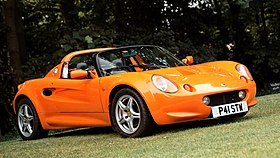Lotus Elise
| Lotus Elise | |
|---|---|

Lotus Elise Series 2
|
|
| Overview | |
| Manufacturer | Lotus Cars |
| Production | 1996–present |
| Assembly |
Hethel, Norfolk, England Shah Alam, Malaysia (Series 1, 1997–2000) |
| Body and chassis | |
| Class | Sports car (S) |
| Body style | 2-door roadster |
| Layout | Transverse mid-engine, rear-wheel-drive layout |
| Chronology | |
| Predecessor | Lotus Elan |
| Series 1 | |
|---|---|
 |
|
| Overview | |
| Production | 1996–2001 |
| Designer | Julian Thomson |
| Body and chassis | |
| Related |
Lotus 340R Vauxhall VX220/Opel Speedster Lotus Elise GT1 |
| Powertrain | |
| Engine | 1.8 L Rover K-series I4 |
| Transmission | 5-speed manual |
| Dimensions | |
| Wheelbase | 2,300 mm (90.6 in) |
| Length | 3,726 mm (146.7 in) |
| Width | 1,719 mm (67.7 in) |
| Height | 1,202 mm (47.3 in) |
| Kerb weight | 725 kg (1,598.4 lb) ~ 755 kg (1,664 lb) |
| Series 2 | |
|---|---|
 |
|
| Overview | |
| Production | 2001–2011 |
| Body and chassis | |
| Related |
Lotus Exige Opel Speedster/Vauxhall VX220 Lotus 2-Eleven Lotus Europa S Tesla Roadster Hennessey Venom GT |
| Powertrain | |
| Engine | 1.8 L Rover K-series I4 1.8 L Toyota 1ZZ-FE I4 1.8 L Toyota 2ZZ-GE I4 |
| Transmission | 5-speed Toyota C56 manual 6-speed Toyota C64 manual |
| Dimensions | |
| Wheelbase | 2,300 mm (90.6 in) |
| Length | 3,785 mm (149.0 in) |
| Width | 1,719 mm (67.7 in) |
| Height | 2002–07: 45.0 in (1,143 mm) 2008–present: 1,117 mm (44.0 in) |
| Kerb weight | 860 kg (1,896 lb) 910 kg (2,006 lb) |
| Series 3 | |
|---|---|
 |
|
| Overview | |
| Production | 2011–present |
| Powertrain | |
| Engine | 1.6 L Toyota 1ZR-FAE I4 1.8 L Toyota 2ZZ-GE I4 (2011 US Models) 1.8 L Toyota 2ZR-FE I4 |
| Transmission | 6-speed Toyota EC60 manual 6-speed Toyota C64 manual (2011 US Models) |
| Dimensions | |
| Wheelbase | 2,300 mm (90.6 in) |
| Length | 3,824 mm (150.6 in) |
| Width | 1,719 mm (67.7 in) |
| Height | 1,117 mm (44.0 in) |
| Kerb weight | 866 kg (1,909 lb) 914 kg (2,015 lb) |
The Lotus Elise is a two-seat, rear-wheel drive, mid-engined roadster conceived in early 1994 and released in September 1996 by the British manufacturer Lotus Cars. The car has a hand-finished fibreglass body shell atop its bonded extruded aluminium chassis that provides a rigid platform for the suspension, while keeping weight and production costs to a minimum. The roadster is capable of speeds up to 240 km/h (150 mph). The Elise was named after Elisa, the granddaughter of Romano Artioli who was chairman of Lotus and Bugatti at the time of the car's launch.
The 1996 Lotus Elise weighed 725 kg (1,598 lb). Because of this low weight, it was able to accelerate 0-60 mph (97 km/h) in 5.8 seconds despite its relatively low power output of 118 bhp (88 kW; 120 PS). Braking and fuel consumption are also improved by the car's reduced weight. Cornering is helped by a low center of gravity height of 470mm (18½").
Series 1 was designed by Julian Thomson, then head of design at Lotus, and Richard Rackham, Lotus's chief engineer.
Besides the standard higher-performance variants listed below, Lotus also released some limited edition models such as Sport 135 (1998/9) with approx 145 bhp (108 kW; 147 PS), Sport 160 (2000) with 150–160 bhp (112–119 kW; 152–162 PS), and Sport 190 (190 bhp (142 kW; 193 PS)). These were more competent on track with sports suspension, wheels and tyres, seats according to model. There were other special editions such as the 50th Anniversary Edition (green/gold) celebrating 50 years of Lotus cars, the Type 49 ("Gold Leaf" red and white two-tone), and Type 79 ("JPS" black/gold) which refers to its successful Grand Prix car type numbers.
The Series 1 Lotus Elise 80 was briefly assembled on a dedicated assembly line at Proton's Shah Alam factory between 1997 and 2000. The Malaysian-assembled Elise costs less than its British-built counterpart as it was manufactured with more Malaysian-sourced components. The Malaysian-assembled Elise was also exported to regional markets, including Japan, Hong Kong, Australia and New Zealand. However, parent company Proton had been severely affected by the 1997 Asian financial crisis, which brought an early end to the Malaysian assembly of the Lotus Elise in late 2000, only three years after it commenced and with an estimated 150 units sold. The Proton-assembled Elises were assigned the code 'B' in the eleventh VIN position, while the original Hethel-built units were stamped with the code 'H'.
...
Wikipedia
